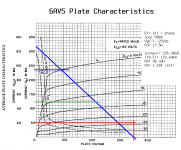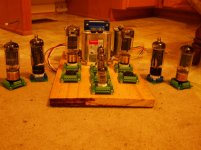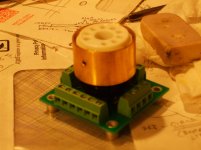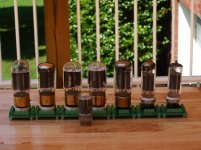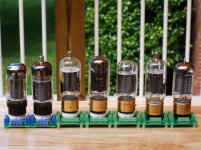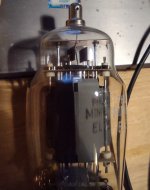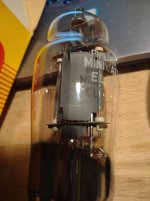Finally building up a real push-pull amplifier using the stash of 12AV5GA I've been hoarding. I'm going for a simple G1 drive, using a set of iron from Antek. I'm going to use a 150 volt dual secondary power transformer, with each winding stacked to give GND, +210, and +420 volts, that way the screen supply can go off of one supply and get regulated down to +150, and the output plates will get the 420 volt supply, with the driver stages being supplied from a further filtered ~400 or so off of the plate supply. plan is 50mA idle, -25V or so g1. My negative will probably be doubled off the lower winding, or use a backwards filament transformer.
I'm using antek power toroids for the output transformers as this has worked well in the past- I ordered transformers with both 5 and 6 volt dual secondaries.
Math if I series connect the secondaries: I will get 4232 ohms off the 5(10) volt version, and 2938 ohms off of the 6(12) volt version. Quick/dirty calculations put a possible ~40 watts or so with the 4k load, and 30 or so with the 3k load, not counting losses.
To drive it all I may use one of my flea amplifier PCBs modified with output load resistors, still deciding how I want to go there.
I'm using antek power toroids for the output transformers as this has worked well in the past- I ordered transformers with both 5 and 6 volt dual secondaries.
Math if I series connect the secondaries: I will get 4232 ohms off the 5(10) volt version, and 2938 ohms off of the 6(12) volt version. Quick/dirty calculations put a possible ~40 watts or so with the 4k load, and 30 or so with the 3k load, not counting losses.
To drive it all I may use one of my flea amplifier PCBs modified with output load resistors, still deciding how I want to go there.
You’re only going to get about 370 volts under full load with that power trafo. And 100 VA might be thin for that size amp, even if you did get 30 watts per. You might try one per channel. I ultimately decide to wind my own PT for a project only 20 watts per channel, because the Antek 100VA 2x150 wouldn’t give me enough B+ under load (I needed 400V, so I had to start at 460). Of course if you’re choosing your output trafo impedance rather than using existing, you can just go lower impedance to get your power back. But you won’t ever be able to start at 420 volts. Plan on a lower B+. These things run right around 88% regulation across the board, no load to full DC load with cap input filters.
Speaking of using Antek power toroids as output transformers - has anyone built an amp where you intentionally use a different HV B+ depending on what speaker impedance is used? Some of the bigger power toroids (ie, the 800 and 1500 VA units) have only one logical way of connecting the secondary (as 120V) effectively giving only one output tap. To get similar power at 4 or 8 ohms, one would have to adjust B+ (And perhaps screen). Has this ever been made practical in a sweep tube amp? Just tying to explore options at this point. I know they do this on some cheap solid state receivers, which can’t otherwise handle 4 ohms. I do have a pair of 900 VA power transformers with taps from 380 to 480 volts, as well as 110/120V tapped primaries. That provides a reasonable adjustment range for B+, which could almost absorb all of the 2:1 change in load impedance I’d get from the “output” transformer going from 4 to 8 ohms. Just wondering if anyone has done this, and maybe found some pitfalls to avoid.
Edcor 3.3K 60 Watt OT available now.
By the way, I just got in some Edcor 60 Watt 3.3K to multiple secondary OTs, for those TV Sweep tube enthusiasts out there. Should be on Edcor's standard product list soon, after they finish a revamp of their website in progress. I wanted something available for the smaller to mid size Sweep tubes, like 6DQ5, 6HJ5, 12GE5, 12JN6, 21HB5, 17KV6, 12GT5, 17JT6, 22JR6, 22JG6, 21LG6, 6EX6, 6CD6..... The bigger Sweeps already have a 100 Watt 3.3K and 2.5K OT available. There is a 60 Watt 4.2K OT there already too.
By the way, I just got in some Edcor 60 Watt 3.3K to multiple secondary OTs, for those TV Sweep tube enthusiasts out there. Should be on Edcor's standard product list soon, after they finish a revamp of their website in progress. I wanted something available for the smaller to mid size Sweep tubes, like 6DQ5, 6HJ5, 12GE5, 12JN6, 21HB5, 17KV6, 12GT5, 17JT6, 22JR6, 22JG6, 21LG6, 6EX6, 6CD6..... The bigger Sweeps already have a 100 Watt 3.3K and 2.5K OT available. There is a 60 Watt 4.2K OT there already too.
Finally building up a real push-pull amplifier using the stash of 12AV5GA I've been hoarding. I'm going for a simple G1 drive, using a set of iron from Antek.
Good for you. I also have a stash of 12AV5's here. Older, B&W type deflection final that also makes an excellent audio final. (Loafline attached). You might want to consider: Le Renard -- a project I did with 6BQ6GA's, which are very much like 6AV5's with top caps. Some folks don't like those plate caps as they bring the HV above the chassis. The audio performance was excellent, and the 6BQ6 worked like a more powerful 6V6, with mainly H3 with a trace of H5+ on the Twin-T test. Without gNFB, the sound was a bit "edgy" and overly "aggressive", but without any of that pentode nastiness unless you were near clipping. The only gNFB needed was enough to take off the "edge".
I was also quite pleased with how the cascoded LTP worked. Even though the 6BQ7A's don't have any suggested audio designs (an RF type with an undocumented variable-u characteristic?) good audio loadlines can be found. Cascoded, they work very well as an LTP and that eliminates the need for an extra gain stage. That was something I carried over from solid state practice, and it works just as well with hollow state.
420V may be a bit much, though the operating point looks quite good, and agrees with a loadline I did. I had an old Stancor power PTX in the junk box that gave the correct voltage with a 5U4GB instead of SS diodes that over volted by about 100V -- the forward drop of the 5U4, so that worked out just fine.I'm going to use a 150 volt dual secondary power transformer, with each winding stacked to give GND, +210, and +420 volts, that way the screen supply can go off of one supply and get regulated down to +150, and the output plates will get the 420 volt supply, with the driver stages being supplied from a further filtered ~400 or so off of the plate supply. plan is 50mA idle, -25V or so g1. My negative will probably be doubled off the lower winding, or use a backwards filament transformer.
40W is a bit much, though it doesn't really make all that much difference. 30W is more than enough to annoy the neighbors if you crank it.Math if I series connect the secondaries: I will get 4232 ohms off the 5(10) volt version, and 2938 ohms off of the 6(12) volt version. Quick/dirty calculations put a possible ~40 watts or so with the 4k load, and 30 or so with the 3k load, not counting losses.
Attachments
I am thinking of sweep tube UNSET-SED next project. I sense ignore the Pd rating as that is too conservative for audio amplifier duty.
I hear others (George) suggest find the red plate Pd then back off a little. Really?
TV HD duty is the epitome of "brick on the key" operation, so the PD ratings are very conservative. For audio and most RF applications, you can bust that spec without compromising tube life.
B&W type deflection final that also makes an excellent audio final. (Loafline attached).
"Loafline" ! , hmmm, probably relaxed loading as opposed to Tubelab's usual setup.
Some folks don't like those plate caps as they bring the HV above the chassis.
For the plate cap phobic, there are 6GF5, 12AV5, 6P41S, 25HX5, 6GE5/6JN6, 12GT5, 17JT6, 22JR6, 22JG6, 17KV6 and 6HJ5. Some European tubes too.
And now you CAN have your cake and eat it too. Adapters (below pic) to make Sweep tubes -LOOK- like conventional Octal Audio tubes. ( faux Octal 6HJ5 and 17KV6 shown, and real Octal 26HU5)
( I made some "gold" tube extenders using Ebay parts. )
Attachments
Last edited:
I am thinking of sweep tube UNSET-SED next project. I sense ignore the Pd rating as that is too conservative for audio amplifier duty.
I hear others (George) suggest find the red plate Pd then back off a little. Really?
TV HD duty is the epitome of "brick on the key" operation, so the PD ratings are very conservative. For audio and most RF applications, you can bust that spec without compromising tube life.
As I stated back in post #1552 the class of operation matters, as does the build quality of the tube.
The UNSET amp is a class A Single Ended design although it does make an killer push pull amp too in class AB.
In SE duty the amp will be burning up almost all of the power supply energy in the CED pair (output tube and cathode mosfet) at idle and low power output. I have spent the past week testing and tweaking out a 25 to 30 watt SE version using 26LW6 or 26HU5 tubes. Getting 25+ watts in SE burns about 60 watts (550 volts at 110 mA) in the output stage. About 2 watts are lost in the DCR of the OPT, 7 watts are brunt in the mosfet, leaving about 50 watts dissipated in the output tube. The 26LW6 is rated for 40 watts of dissipation while the 26HU5 is rated at 35 watts. These tubes have exactly the same plates in them. At least in the UNSET, they are interchangeable with only a minor bias adjustment. The 26LW6 can be found in two different GE versions, and a Sylvania version.
I stuffed every 26LW6 tube that I have in the UNSET board, and over dozen 26HU5's. There are several of each that can run at 55 to 60 watts of dissipation in the tube with no visible glow in a dark room, and about an equal number that shows a visible glow on one corner, or one side of the plate in the 45 watt range. Most show a faint glow at 50 watts. This is dependent entirely on the quality of construction, especially alignment of the individual elements. Any misalignment will result in unequal current (and heat) distribution across the plate surface.
I briefly considered trying a bigger tube (the 4D32 rated for 50 watts of dissipation) but the curves convinced me that I couldn't get there either.
I then wired the board for PSE operation. Running two 26HU5's in parallel gets me 30 watts at 1.5% THD and 33 watts at 5% THD on 660 volts at 65 mA per tube. This is using a lossy Hammond 1628SEA OPT. The Edcor CSXE25 will get me 2 or 3 more watts at the same operating points, so I should get 35 watts at 5% or less.
I could cherry pick through my tubes and get 25 watts from a single tube, but I'll save the cherries for my kilowatt (500 WPC) push pull amp using the same design in push pull.
I missed a few plate cap-less TV Sweeps in post # 1568 above:
21HB5A, 6/12/38HE7, 10JA5, 6JC5, 6AU5, 6W6 (/ 12L6/ 6GC5/ 6DG6/ 6CU5/ 6DB5 )
6L6... and 6V6 were old time cap-less Horiz. and Vert. sweeps
Pic 1 has some of the less common cap-less Sweeps
L to R: 21HB5A, 6JC5, 10JA5, 38HE7, 17KV6, 6P41S, 25HX5, (and the little but still mighty 6GF5 in front)
6P41S and 25HX5 are Magnoval base, hence the Magnoval to Novar adapter under them here.
21HB5A was on the $1 list for years (as were 6GF5 and 12/38HE7).
38HE7 is a pentode/damper combo. Also on the $1 (and $0.35 in quant.) lists. About 3/4 of the 38V Htr versions I have seen have the pentode Htr available alone on pins 10 and 12. Becomes 21V Htr for the pentode alone. The pent. can be up-rated to 15 Watts then, without the damper heat.
--------------------------------
pic 2 are tubes belonging to the Sweep Tube "Conundrum" group!
All of these have a 35 mm long plate in a 1.5 inch diameter bottle. But they have wildly varying plate dissipation ratings. L to R:
6L6GC 35 Watt
6DQ5 24 Watt
21LG6A 28 Watt
6HJ5 24 Watt
21HB5A 18 Watt
24LQ6/24JE6A 30 Watt
17KV6A 28 Watt
some comments:
6L6GC 35W, this is an Audio rating, not a Sweep tube rating
6DQ5 24W, a reasonable Sweep tube rating. The pictured tube is one of the "odd" 6DQ5 tubes around, having guts with "winglets" just like 6LQ6, 6JE6C and 6LG6A. (and having curves just like them too! )
21LG6A 28W, a reasonable Sweep rating. This was a later tube, having an improved cathode with reduced heater power required, reduced screen current, and plate "winglets" for extra cooling, (RCA has a grid 1 cooler fin instead of "winglets") , 28 Watt is believable
6HJ5 24W, a reasonable Sweep rating, very similar to 6DQ5 except no plate cap.
21HB5A 18W, this is certainly a conservative Sweep rating, although most 21/6HB5 types do not have the grid1 cooler shown in this pic. The pic'd tube was a GE version made for reliable IBM computer monitors, I'll bet it can do 22 Watts reliably (sweep tube use) with the grid1 cooler. This was on the $1 list for some time, no one ever seemed to pick up on these for audio. Somewhat higher gm for its size. Nice curves.
24LQ6/24JE6A 30W, maybe not. RCA came out with this in 1967, and Sylvania said it wasn't really a 30 Watt tube. Then 6ME6, 6JE6C and later 6MJ6 all came out as equivalent tubes with -high- reliability prominently mentioned. The 6/21LG6A tube also has identical guts to 6LQ6 and 6JE6C, rated 28 Watt, and identical curves. (and 1/10 the price of 6LQ6 lately, not pin compatible)
6/17KV6A 28 Watt, maybe not. The first data sheet for 6KV6 was identical to the 20 Watt 6KM6, except now no plate cap and rated as a TV HV pulse regulator. Then the A version came out with reduced grid 2 Watts and increased plate Watts for regulator service. The similar 6JE6C tube allows trading -1 Watt of grid 2 for +4 Watts of plate. Looks like that is what they did here. The 3.5W 6KV6 grid2 got reduced to 2 Watts (for regulator service instead of Sweep service), allowing 6 more Watts of plate and the grid1 got a cooler fin, for another 2 Watts. For ordinary TV Sweep tube service, I would call it a 22 Watt tube.
(the "gold" bases in the pics are an add on extender made from parts off Ebay, almost look Octal)
21HB5A, 6/12/38HE7, 10JA5, 6JC5, 6AU5, 6W6 (/ 12L6/ 6GC5/ 6DG6/ 6CU5/ 6DB5 )
6L6... and 6V6 were old time cap-less Horiz. and Vert. sweeps
Pic 1 has some of the less common cap-less Sweeps
L to R: 21HB5A, 6JC5, 10JA5, 38HE7, 17KV6, 6P41S, 25HX5, (and the little but still mighty 6GF5 in front)
6P41S and 25HX5 are Magnoval base, hence the Magnoval to Novar adapter under them here.
21HB5A was on the $1 list for years (as were 6GF5 and 12/38HE7).
38HE7 is a pentode/damper combo. Also on the $1 (and $0.35 in quant.) lists. About 3/4 of the 38V Htr versions I have seen have the pentode Htr available alone on pins 10 and 12. Becomes 21V Htr for the pentode alone. The pent. can be up-rated to 15 Watts then, without the damper heat.
--------------------------------
pic 2 are tubes belonging to the Sweep Tube "Conundrum" group!
All of these have a 35 mm long plate in a 1.5 inch diameter bottle. But they have wildly varying plate dissipation ratings. L to R:
6L6GC 35 Watt
6DQ5 24 Watt
21LG6A 28 Watt
6HJ5 24 Watt
21HB5A 18 Watt
24LQ6/24JE6A 30 Watt
17KV6A 28 Watt
some comments:
6L6GC 35W, this is an Audio rating, not a Sweep tube rating
6DQ5 24W, a reasonable Sweep tube rating. The pictured tube is one of the "odd" 6DQ5 tubes around, having guts with "winglets" just like 6LQ6, 6JE6C and 6LG6A. (and having curves just like them too! )
21LG6A 28W, a reasonable Sweep rating. This was a later tube, having an improved cathode with reduced heater power required, reduced screen current, and plate "winglets" for extra cooling, (RCA has a grid 1 cooler fin instead of "winglets") , 28 Watt is believable
6HJ5 24W, a reasonable Sweep rating, very similar to 6DQ5 except no plate cap.
21HB5A 18W, this is certainly a conservative Sweep rating, although most 21/6HB5 types do not have the grid1 cooler shown in this pic. The pic'd tube was a GE version made for reliable IBM computer monitors, I'll bet it can do 22 Watts reliably (sweep tube use) with the grid1 cooler. This was on the $1 list for some time, no one ever seemed to pick up on these for audio. Somewhat higher gm for its size. Nice curves.
24LQ6/24JE6A 30W, maybe not. RCA came out with this in 1967, and Sylvania said it wasn't really a 30 Watt tube. Then 6ME6, 6JE6C and later 6MJ6 all came out as equivalent tubes with -high- reliability prominently mentioned. The 6/21LG6A tube also has identical guts to 6LQ6 and 6JE6C, rated 28 Watt, and identical curves. (and 1/10 the price of 6LQ6 lately, not pin compatible)
6/17KV6A 28 Watt, maybe not. The first data sheet for 6KV6 was identical to the 20 Watt 6KM6, except now no plate cap and rated as a TV HV pulse regulator. Then the A version came out with reduced grid 2 Watts and increased plate Watts for regulator service. The similar 6JE6C tube allows trading -1 Watt of grid 2 for +4 Watts of plate. Looks like that is what they did here. The 3.5W 6KV6 grid2 got reduced to 2 Watts (for regulator service instead of Sweep service), allowing 6 more Watts of plate and the grid1 got a cooler fin, for another 2 Watts. For ordinary TV Sweep tube service, I would call it a 22 Watt tube.
(the "gold" bases in the pics are an add on extender made from parts off Ebay, almost look Octal)
Attachments
Last edited:
Most vertical sweeps are capless, but they seem to top out around 19 watts and 300 mA plate current (w/o going AB2). Most of them clock in at 12 to 14 watts. You just don’t need as much power to deflect the beam at 60 Hz as you do at 15.7k. Some verticals have pretty curves that kind of remind you of a 7591 that runs on half the screen voltage. Some like the 6W6 seem to be good general purpose power amps when you don’t have any voltage to work with.
But you can really only get a lot of juice out of horizontal sweeps because you can push more current through them and run them well above 400V if you want to. There only seem to be a handful of capless versions of those 24+ watt tubes. And all of ones I can get are 12 pin compactrons. Novar aren’t any better anyway, since the sockets are even harder to come by. Nice easy to use octals - forgetaboutit. You’re gonna get a cap with that. The plate voltage IS intended to spike in to several kV in flyback so it does make sense.
But you can really only get a lot of juice out of horizontal sweeps because you can push more current through them and run them well above 400V if you want to. There only seem to be a handful of capless versions of those 24+ watt tubes. And all of ones I can get are 12 pin compactrons. Novar aren’t any better anyway, since the sockets are even harder to come by. Nice easy to use octals - forgetaboutit. You’re gonna get a cap with that. The plate voltage IS intended to spike in to several kV in flyback so it does make sense.
You just don’t need as much power to deflect the beam at 60 Hz as you do at 15.7k.
The power needed to deflect the beam vertically or horizontally is about the same. The horizontal sweep tube is also used to make the high voltage for the CRT. A 25 inch color CRT runs three electron guns aimed at a metal shadow mask with an average current around 500 to 1000 microamps depending on the overall scene brightness.
Until the regulator was moved to the primary side of the flyback to reduce X-ray emission, the HV was regulated with a shunt regulator triode eating its share of the excess current. Typical total HV current was about 1 to 1.5 mA at 25 to 27 KV or about 30 watts, added to the power used to deflect the beam. Thus a good share of the power provided by the horizontal sweep tube was only used to heat up the plate of the HV regulator tube, and make X-rays.
The vertical sweep section of a tube TV was a class A SE audio amp, optimized for a single frequency, 60 Hz or 59.97 Hz in the US NTSC system. I exploited this a lot in my younger days by lifting the complete vertical sweep circuit from an old TV, and breaking the feedback loop to insert a 1/4 inch jack, to make guitar amps. As a SE amp running class A, the efficiency was pretty low. The horizontal sweep section runs near saturation for part of its cycle getting far better efficiency. Older TV's had a coil that tuned the efficiency.
I did a search of this thread and did not see any posts on the el38. I assume it is because it was used in the UK. I stumbled onto them as a suitable tube to use in my 6l6/el34 cathode bias SE pentode amp. Gotta say, they are a remarkable sounding tube in this amp. Super clarity and bass control. I've heard rumors that they are related to the Mullard EL34 and even the KT77.
I've seen people talk about using them as triodes but not as single ended pentodes. With 290v regulated screen and an unknown, but safe for 6l6g, voltage on the plate they sound amazing. I assume at these voltages they should have a long life, right?
I've seen people talk about using them as triodes but not as single ended pentodes. With 290v regulated screen and an unknown, but safe for 6l6g, voltage on the plate they sound amazing. I assume at these voltages they should have a long life, right?
Does anyone have any views on the PCL200? I can pick up 30 or so, and the data looks interesting, but the decal base makes it a trickier call.
I acquire tubes thinking I will do something with them, but if you are planning a PP amp, then you really need 8 or 12 anyway, if they are not run of the mill, so that spares are not a concern, and balanced pairs are possible.
I acquire tubes thinking I will do something with them, but if you are planning a PP amp, then you really need 8 or 12 anyway, if they are not run of the mill, so that spares are not a concern, and balanced pairs are possible.
They certainly look robust enough! They must have been a pain to produce, with those ceramic spacers.
They are handsome tubes and I've never seen so much blue glow before. Also wondering if biasing them like a 6l6g would do them any harm. My amp is cathode bias.
According to the tube data sheet, they have a max rating of 800V / 400V for anode/screen, so would look to be tougher than a 6L6G which is rated 360V/270V resp.
I have acquired a few and am looking forward to having the time to try them in my Tubelab SSE instead of EL34s. I've also heard that they have a sound (one reviewer said it was 'dark').
I have acquired a few and am looking forward to having the time to try them in my Tubelab SSE instead of EL34s. I've also heard that they have a sound (one reviewer said it was 'dark').
According to the tube data sheet, they have a max rating of 800V / 400V for anode/screen, so would look to be tougher than a 6L6G which is rated 360V/270V resp.
I have acquired a few and am looking forward to having the time to try them in my Tubelab SSE instead of EL34s. I've also heard that they have a sound (one reviewer said it was 'dark').
I’ve heard them in two different amps. They are both cathode bias and so were unable to be optimized for the EL38. But in both systems the sound was not what I would call dark. Instead they were open and had a remarkable sense of clarity. My amp is running single ended pentode and the bass is noticeably tighter than my 6ar6 and 807.
My amp changes the voltage going to the output tubes plates by changing the rectifier. I’ve been using a 5u4g like I do with my 807 tubes. Sounds like I could move up to the 5ar4 like I do with the KT88.
The EL38 has climbed in value so maybe it is no longer as attractive as some of the other tubes in this thread. I will say that having honest to God Millard tubes (with the big and beautiful blue and orange boxes) makes this audiophool quite happy. The sound lives up to the label’s reputation.
The main reason of the different power requirements is the different deflection angles vertically vs. horizontally rather than the different frequencies. As yet said above, the vertical deflection amplifier resembles an audio amplifier (which should demand for higher plate dissipation), while the horizontal sweep stage is a switch, at least in European designs.You just don’t need as much power to deflect the beam at 60 Hz as you do at 15.7k.
PCL200 has been designed to drive the CRT cathode(s) directly. It's not a deflection tube. The pentode is a high gm frame grid one, while the triode resembles half a 12AT7.Does anyone have any views on the PCL200?
Best regards!
According to the tube data sheet, they have a max rating of 800V / 400V for anode/screen, so would look to be tougher than a 6L6G which is rated 360V/270V resp.
Just for accuracy's sake,
6L6 (metal), 6L6G, 6L6GA, 6L6GB are max rated for 360V/270V plate/screen. (19 watts plate, 2.75W screen)
6L6GC is max rated for 500V/450V plate/screen (30 watts plate, 5W screen).
The Sylvania/Philips ECG, RCA or GE 6L6GC of yore was a stout beam pentode. (Whether or not it was any good, I don't know...)
Not that there's anything at all wrong with an EL38!
--
- Home
- Amplifiers
- Tubes / Valves
- Those Magnificent Television Tubes
